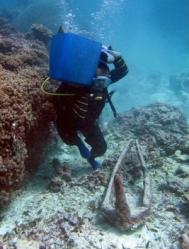Robin McDowell / Associated Press
Source - http://abcnews.go.com/International/wireStory/indonesias-shipwrecks-riches-headaches-16044425#.T3yPGas5Lbo
Mamat Evendi straps on his primitive breathing device — a garden hose attached to a compressor on the back of his wooden fishing boat. Pulling down his goggles, he splashes flippers-first into the crystal blue water

A diver examines a piece of a plate from what is believed to be a 17th century Dutch East India Company (VOC) shipwreck in Mentawai Islands, Indonesia [Credit: AP/Dita Alangkara]
A few minutes later he's flashing a "thumbs up," pointing first to a massive, coral-encrusted anchor, then a bronze cannon and finally, peeking up from the sand, the buried deck of a 17th century European ship. Nearby are pieces of blue-and-white ceramics. A tiny perfume bottle. A sword handle. Broken wine flasks, one still sealed with a wooden cork.

Hardimansyah, a local maritime official who has taken it upon himself to protect shipwrecks, examines a piece of ceramic found on the ocean floor from what is believed to be a 17th century Dutch East India Company (VOC) shipwreck at Mentawai Islands, Indonesia [Credit: AP/Dita Alangkara]
The wreck is just 6 meters (20 feet) underwater, one of four pushed into view after a tsunami slammed into the Mentawai Islands of Indonesia just over a year ago. They are among possibly 10,000 vessels littering the ocean floor of what for more than a millennium has been a crossroads for world trade.
For historians, the wrecks are time capsules, a chance to peer directly into a single day, from the habits of the crew and the early arrival of religion to contemporary tastes in ceramics.
But for Evendi and other fishermen involved in the new discoveries, it's not the past they see. It's the future. A chance, maybe, to strike it rich.

Fred Dobberphul, a scientific diver who involved in the excavation of the 9-10th century Chinese ship that sank off Java island and known as "The Cirebon Wreck", examines artifacts he helped to recover at a government warehouse in Cileungsi, West Java, Indonesia [Credit: AP/Dita Alangkara]
"They keep telling me, 'Let's just break them open, get the stuff out,'" said Hardimansyah, a local maritime official who has taken it upon himself to protect the wrecks as the government wrangles over a new policy on underwater heritage.
"To be honest, I'm getting frustrated, too," he says, noting he's already given the best artifacts pulled from the coral and sand to military and political officials who stop by his office from time to time to see what's been found.
"Gifts," he calls them, or "offerings."
"It's hard to say no if they ask.
Indonesia — a sprawling archipelago nation straddling the equator — remains desperately poor despite its vast oil, coal and gold reserves. Its graveyard of ships from Asia, Europe and the Middle East — one of the biggest in the world with nearly 500 wrecks identified so far — has long been coveted as yet another resource to exploit.
The most valuable, packed with everything from 9th century ceramics and imperial-quality gold boxes to exquisite jewels, funeral urns and inkwells, can bring in tens of millions of dollars.
That has created a small, lively industry for fishermen, who are often the discoverers of the wrecks. Those that aren't immediately looted have been sold to commercial salvage companies, which pull up the cargo as quickly as possible and then sell it off piece by piece at international auctions.
The government, which gets 50 percent of all proceeds and half the cargo, decided to wrest greater control over the riches of the sea after being left empty-handed following one of the most significant hauls, a 9th century Arab sailing vessel whose presence pointed to previously unknown trading links between China and the Middle East.
"It's frustrating," said Horst Liebner, an expert on Indonesia's maritime history, who has helped catalog artifacts and shipbuilding techniques for both the government and salvage crews. "Because in the end, this isn't about the odd treasure chest guarded by an octopus. It's about the knowledge we can gain from proper excavation."
With tens of thousands of artifacts already handed over, Indonesian museums should by now be richly stocked. Instead, shelves are all but bare. The most exquisite pieces have "disappeared." And those of little or no monetary value are in musty warehouses, closed to the public.
Pictures remain on disk drives and painstaking research goes unpublished.
"In the end, all the artifacts, everything you put into data-basing," said Liebner, "it's just for nothing in this country, it seems. No one cares."

A diver carries a bucket full of artifacts from what is believed to be a 17th century Dutch East India Company (VOC) shipwreck as an unidentified sip part lies on the ocean floor in Mentawai Islands, Indonesia [Credit: AP/Dita Alangkara]
For-profit excavations in the sea are legal in several countries, including Indonesia, that have yet to sign a 2001 U.N. convention on protecting underwater cultural heritage. But they rarely spark the outrage they would if carried out on land.

A diver swims near an anchor of what is believed to be a 17th century Dutch East India Company (VOC) shipwreck in Mentawai Islands, Indonesia [Credit: AP/Dita Alangkara]
That's in part because maritime archaeology is a relatively new discipline, developed only after World War II, and neither lawmakers nor the public have kept pace with the technological advances that have turned it from a romantic hobby into a thriving business.
PART. 2